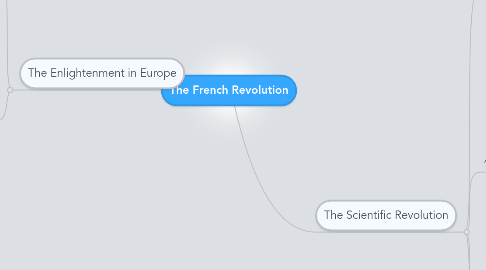
1. The Enlightenment in Europe
1.1. Two Views on the Government
1.1.1. Hobbes Social contract
1.1.1.1. Thomas Hobbes argued that to escape such a bleak life, people must have an absolute leader in what he called a social contract.
1.1.2. Locke's Natural Rights
1.1.2.1. John Locke a philosopher thought that people could learn from experience and improve themselves and govern themselves rather than being ruled.
1.2. The Philosophes Advocate Reason
1.2.1. Enlightenment reached its height in France in the mid- 1700s
1.2.2. The French word for philosopher was philosophe
1.2.3. Enlightenment thinkers argued that people should live by 5 core beliefs 1.Reason 2.Nature 3.Happiness 4.Progress 5.Liberty
1.2.4. Voltaire Combats Intolerance
1.2.4.1. Voltaire was the pen name for Francois Marie Arouet
1.2.4.2. He criticized the clergy and aristocracy frequently, through satire to try and get equality throughout
1.2.5. Other Important Enlightenment people
1.2.5.1. Montesquieu was an advocate for the study of political liberty
1.2.5.2. Rousseau was a strong advocate of individual freedoms
1.2.5.3. Beccaria was a philospher that took interest in the justice system
2. The Scientific Revolution
2.1. The Roots of Modern Science
2.1.1. The Medeival View
2.1.1.1. Before 1500, scholars decided on whether things were true or not by referring to religious writings.
2.1.1.2. People used to think that the Earth was the center of the universe and that the sun as well as other planets revolved around it in an idea called the geocentric theory
2.1.2. A New Way of Thinking
2.1.2.1. In the mid 1500s scholars started publishing works that would conflict with the ideas of ancient thinkers and the church
2.1.2.2. The influx of new ideas challenging classical thinking was considerred the start of the Scientic Revolution.
2.1.2.3. The Scientific Revolution was a new way of thinking about the natural world.
2.2. A Revolutionary Model of the Universe
2.2.1. The Heliocentric Theory
2.2.1.1. Copernicus studied planetary movements for more than 25 years and argued that the stars, earth, and other planets revolve around the sun.
2.2.1.2. Copernicus' theory was called the heliocentric theory, or sun centered. Although it explained that they did, it did not explain why they revolved around the sun.
2.2.1.3. Copernicus feared that the scholars and clergy would reject his findings so he didn't publish his work until the last year of his life.
2.2.2. Galileo's Discoveries
2.2.2.1. Galileo Galilei built on the new theories about astronomy and built a telescope to observe the sky
2.2.2.2. Galileo published his findings that described the moons uneven surface and supported the findings of Copernicus
2.2.3. Conflict with the Church
2.2.3.1. Galileos findings angered the church and he was forced to live under house arrest until he died
2.3. The Scientific Method
2.3.1. Bacon and Descartes
2.3.1.1. The scientific method came about which was a logical procedure for gathering and testing ideas.
2.3.1.2. Rene Descartes was a mathematician who developed analytical geometry and developed a thought process of doubting everything until proven.
2.4. Newton Explains the Law of Gravity/Scientific Revolution Spreads
2.4.1. Sir Isaac Newton published his works: "The Mathematical Principles of Natural Philosphy" which explained that the universe operates much like a clock, very orderly
2.4.2. Scientific Instruments
2.4.2.1. New Instruments came about
2.4.2.1.1. The Microscope
2.4.2.1.2. The Mercury Barometer
2.4.2.1.3. Francis Bacon an English statesman/writer developed a way of thought that involved experimenting and then drawing conclusions
2.4.2.1.4. The thermometer
2.4.3. Medicine and the Human Body
2.4.3.1. Edward Jenner created a vaccine to prevent smallpox
2.4.3.2. People learned that the human anatomy was much different from animals
